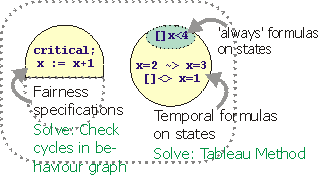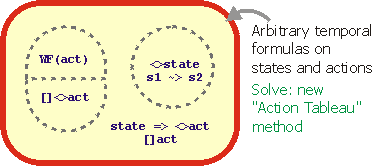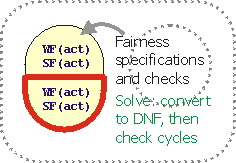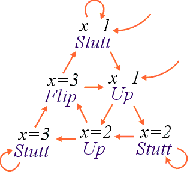
 How to verify temporal formulas in TLA
How to verify temporal formulas in TLA
— Report
Summary
Lamport's "Temporal Logic of Actions" is a temporal
logic that includes actions — i.e. transitions between states.
The conventional Tableau technique of Clarke and Emmerson [1981],
used to verify temporal formulas, does not handle actions.
We present the Action Tableau technique, which does handle
actions. The technique was partly developed and implemented during
a summer internship at Compaq Systems Research Center.

 Related work
Related work
— Research groups
| TLA |
Temporal Logic of Actions - uses the same logical notation for both specification and checks
Lamport et al
|
|---|
| TLC |
Model checker for TLA
Lamport,
Yu et al
|
|---|
| SPIN |
Model-checker - write specifications in PROMELA, use Buchi automata to verify temporal formulas.
Vardi, Wolper, Holzmann et al |
|---|
| Clark & Emerson [1981] |
"Design and synthesis of synchronization skeletons using branching time temporal logic."
The Tableau method.
|
|---|
| STeP |
Stanford Temporal Prover - write in SPL, use Tableau method to verify arbitrary temporal formulas.
Manna, Pnueli et al.
Book "Temporal Verification of Reactive Systems".
|
|---|

 Introductory 1/4
Introductory 1/4
— TLA Overview
TLA is a logic for describing systems that go from state to state.
You can write properties about states
x = 3
You can write how a system moves from one state to another - transitions -
actions
x' = x+1
You can use temporal operators
[] (always),
<> (eventually),
~> (leads-to),
O (next)
[] x<4
x=2 ~> x=3
O([] x<4)
 Actually, there is no Next operator
O in TLA, because its inclusion would lead to problems.
It is however needed to construct a tableau, which is why we introduced it here.
Actually, there is no Next operator
O in TLA, because its inclusion would lead to problems.
It is however needed to construct a tableau, which is why we introduced it here.

 Introductory 2/4
Introductory 2/4
— The reason for TLA
Conventional model-checkers:
- use a special programming language (PROMELA, SPL)
- write checks as temporal formulas on states
if (x==3) {noncritical; x=1;}
else {critical; x=x+1;}
TLA says:
- It's error-prone to write in a new programming language
- Let us write spec and check in the same language: logic!
- Hence, the need for actions. Compare below.
- but actions are a two-edged sword...
with actions: without:
x'=x+1 Exists y: x=y /\ O(x=y+1)
solvable unsolvable in general
also, O not in TLA

 Introductory 3/4
Introductory 3/4
— Model-checker overview
Model: a possible execution trace of Spec
Model-checker: program to verify that all models satisfy Check
(simplistic) Check "always" formulas about states.
"always, the state will be such with no dangling pointers"
"always, the state will have no more than ten items in the buffer"
(tableau) Check arbitrary temporal formulas about states.
"if I put a datum into my reliable-transport-protocol, then the datum will eventually come out the other end"

To check "always" formulas about states is easy: just go through every possible
state, and see if the formula holds. This is what TLC did, before the project.
Although it sounds simplistic, it is still useful! For example, TLC found some problems
in the cache-coherency protocol of an Alpha chip currently
in design.
Paper
available.)

 Introductory 4/4
Introductory 4/4
— Action tableau and model-finding
Action tableau: new technique to handle arbitrary TLA formulas
in specifications and as checks
freely using the temporal operators [], <>
about transitions as well as states
"although this wire may be lossy, it will not do 'fail' transitions from now to eternity"
"if the event gets signalled, then my process will eventually wake up"
In fact we can turn specification and check into one giant formula.
Model: a model of the formula Spec /\ -Check
Model-checker: check whether a model exists

 A mod-3 counter
A mod-3 counter
— Fairness in the state graph
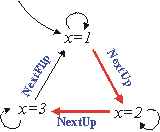
"If the transition becomes takeable infinitely often, it must be taken infinitely often"
[]<>Enabled(NextUp) => []<>Taken(NextUp)
equivalently, SF(NextUp).
"Strong Fairness".
 Strong and weak fairness
Strong and weak fairness

"Strong Fairness: if Next is enabled infinitely often, then it must be taken infinitely often"
s1,s2,s1,s2,... is illegal under SF(Next)
"Weak Fairness: if we get in a state where Next is perpetually enabled, it must eventually
be taken"
s1,s2,s1,s2,... is legal under WF(Next)

 Compositionality
Compositionality
— Why we allow 'stutter' steps
So that we can replace a bit of code,
we always allow stutter-steps.
| hclock |
hmclock |
(m) hmclock |

|

|

|
[] (tick \/ stutter)
SF(tick)
(In fact TLA always implicitly allows stutter-steps as part of its very syntax).

 Example code
Example code
— TLA Specification
Init: x=1
NextUp: x<3 /\ x'=x+1
NextFlip: x=3 /\ x'=1
LiveSpec: SF(NextUp)
Spec: /\ Init
/\ [] (NextUp \/ NextFlip \/ stutter)
/\ LiveSpec
Check: /\ (x=3) ~> (x=1)
/\ SF(NextFlip)
/\ [] x<4
The user asks: does Spec => Check ?
In answer, we will attempt to find a counter-example.
i.e. a case where Spec and Not(Check) hold.

 Scope of solution 1/3
Scope of solution 1/3
— Existing model-checkers, Tableau
Existing model-checkers:
- Separate between fairness spec, logic checks
- Logic checks decided using Tableau method
(TLC only checked "always state" properties, before.)

 Scope of solution 2/3
Scope of solution 2/3
— Arbitrary Formulas, Action Tableau
New Technique 1: Action Tableau
- Generalise the Tableau technique to handle actions as well as states
- Work on Action Tableau not yet finished
- Everything else just a special case of action tableau

 Scope of solution 3/3
Scope of solution 3/3
— Fairness, Disjunctive Normal Form
New Technique 2: Disjunctive Normal Form
- With TLA actions, fairness spec+check can be written in logic
- Disjunctive Normal Form rearranges them into a decidable form
- Succesfully implemented within TLC
- (DNF linear time; same with action tablueau would be exponential)

 The Tableau Method
The Tableau Method
— Does execution trace satisfy temporal formula?
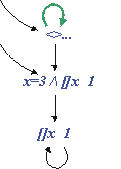
Turn a temporal formula on states
into a finite-state machine,
which accepts only those execution traces that satisfy the formula.
We want a counter-example to Spec=>Check:
= Not(Check)
= Not(x=3 ~> x=1)
= <>(x=3 /\ []x≠1)
Only consider fulfilling cycles. The green cycle is not fulfilling:
it makes the promise <>..., but does not deliver.

 Behaviour Graph
Behaviour Graph
— Traces that satisfy spec and formula
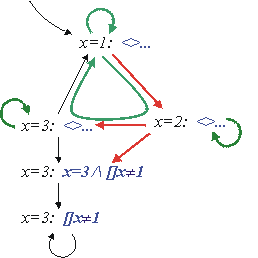
Do cross-product: state * tableau
all paths in it are consistent with the state graph:
Init /\ []Next
all paths in it are consistent with the tableau:
Not(Check)
Goal: to find cycle
that
is fair (if red is takeable, take it eventually)
fulfills its promises (don't stay on greens)
Answer: (1n2n3n)n3ω
 Goal: to find a component
Goal: to find a component
A strongly connected component in a graph is a maximal subset of
nodes and edges such that every node is reachable from every other node.
There are an infinite number of cycles, but they always end up contained within a component. Components completely capture every possible cycle.
There are standard algorithms for finding components. We use Targan [1972]. A neat
online reference is by Prof. Eppstein as
course-notes for his algorithms class.
Once the components are found, we check that they are fair and fulfilling:
An eventually-always formula <>[]a means: remove all edges from the component that do not satisfy a, and
find components in what is left.
An always-eventually formula []<>a means: that
a must be present somewhere in the component that's left.
(You see why fairness the conditions eventually-always and always-eventually are
so significant: they are temporal formulas which have no need of tableaux, because
they merely describe properties of the final within-component loop of a cycle.)
Fulfilling: if we have <>p, which promises
p, then we need in the component at least
one node which either doesn't have <>p, or which
does have p. You need to think subtly to figure out why
this is correct. Hint: by construction of the tableau, the only way to get from
a <>p to something without <>p
is by actually fulfilling it! Incidentally, although it is true that
Not([]p) promises Not(p),
we don't consider it: since our disjunctive normal form pushed all negations inside.
If a component passes all these tests, then it is a valid counter-example
and we are finished. If no component passes all tests, then there are no
counter-examples.
The reference we used for all this is Temporal Verification of Reactive Systems:
Safety by Manna and Pnueli, but we treat eventually-always and
always-eventually a little more generally.

 Action tableaux 1/3
Action tableaux 1/3
— Machine for states and actions
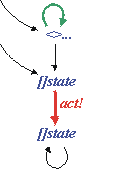
Basic idea: put actions into the tableau graph.
Subject of ongoing work.

 Action tableaux 2/3
Action tableaux 2/3
— Merge Spec and Check into one big formula
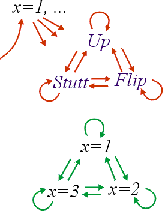
In fact, can express all of Spec/\-Check as
a single formula, in a single action tableau.
Before, we used to cross tableau with state-transition graph of Spec.
But now, Spec has been merged into the tableau...
We cross action-tableau with the trivial universal state transition graph
(fragment shown in green; needs no explicit storage; every state connects
to every other state).
NextUp: x<3 /\ x'=x+1
NextFlip: x=3 /\ x'=1
NextStutt: x'=x
Formula: /\ x=1
/\ [] (\/ NextUp
\/ NextFlip
\/ NextStutt)

 Disjunctive normal form
Disjunctive normal form
— General handling of fairness spec check
Not( SF(NextUp) => SF(NextFlip) /\ 3~>1 )
Optimization to reduce cost for fairness validation.
Express formula in disjunctive normal form. (preserves meaning)
Then look for cycles, as before.
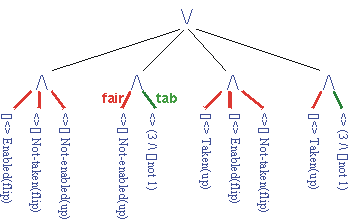

 Implementation
Implementation
— TLC in action
(Sorry! TLC not yet publically released, so no interactive version available.)
tlclive egtalk
TLC Version 1.0 of 3 Jun 1999
Running Random Simulation with seed 7395095282892744306.
Found a counter-example!
The counter-example satisfies these parts from the spec:
<>[]- (state:LiveSpec.fair_enabled)
The counter-example satisfies this temporal formula:
<>(LiveCheck.conj0.cause) /\ []-(LiveCheck.conj0.effect)
And these are the states from which counter-example
cycles might be constructed:
* Behaviour-graph-node 5
particle formulas: []-(state:LiveCheck.conj0.effect),
State fingerprint: -4900539538744082733
/\ x = 3
Here endeth the counter-example.
[and there's a second counter-example...]
Finished checking.





